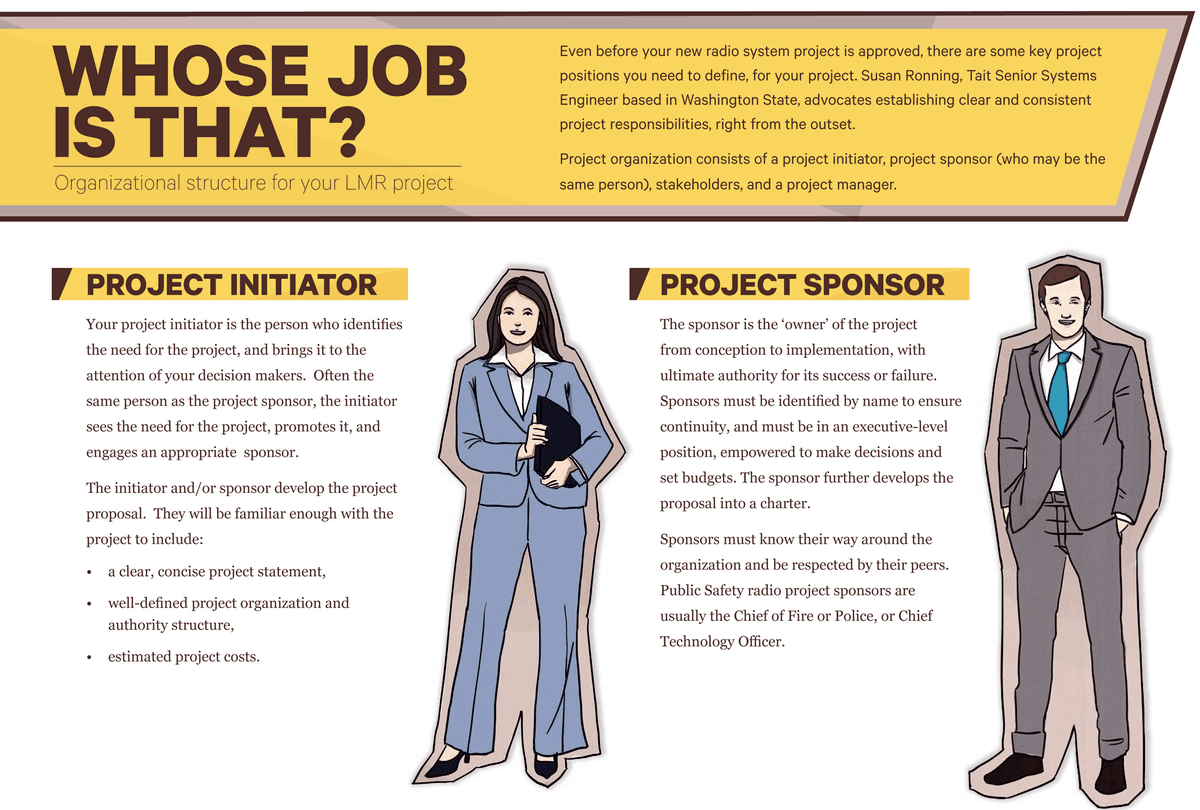Even before your new radio system project is approved, there are some key project positions you need to define, for your project.
Susan Ronning, Tait Senior Systems Engineer based in Washington State, advocates establishing clear and consistent project responsibilities, right from the outset.
Project organization consists of a project initiator, project sponsor (who may be the same person), stakeholders, and a project manager.
Project Initiator
Your project initiator is the person who identifies the need for the project, and brings it to the attention of your decision makers. Often the same person as the project sponsor, the initiator sees the need for the project, promotes it, and engages an appropriate sponsor.
The initiator and/or sponsor develop the project proposal. They will be familiar enough with the project to include:
- a clear, concise project statement,
- well-defined project organization and authority structure,
- estimated project costs.
Project Sponsor
The sponsor is the ‘owner’ of the project from conception to implementation, with ultimate authority for its success or failure. Sponsors must be identified by name to ensure continuity, and must be in an executive-level position, empowered to make decisions and set budgets. The sponsor further develops the proposal into a charter.
Sponsors must know their way around the organization and be respected by their peers. Public Safety radio project sponsors are usually the Chief of Fire or Police, or Chief Technology Officer.
Stakeholders
Your stakeholders are representatives of the departments, agencies, or entities impacted by the project. They can come from inside or outside your organization depending on the project type and scope. The amount and type of input from each stakeholder must be defined early in the project process, and like the project sponsor, stakeholders should be identified by name to ensure continuity.
The project sponsor must work closely with all the stakeholders to ensure their continued buy-in into the project. Stakeholders for public safety radio systems generally include a representative from each department (fire, police, dispatch, public works) and outside agencies that would be impacted, including adjacent fire departments, and state police agencies.
Project Managers
Responsible for delivering the project outcome, the project manager could be an employee of your organization, or may be contracted for this position. Once the project is approved, they will coordinate all players involved in project delivery: designers, manufacturers, and contractors; but will not have authority to address the roadblocks a project might encounter. The project sponsor must form a partnership with the project manager, and it is the sponsor who must enable the project manager to deliver a successful project, through their active support and involvement.
The project manager may lead the project alone, or with a project management team, depending upon scope, scale and skill set requirements.
So to sum up, an organizational structure with clear lines of authority established at the outset will ensure a successfully project, and project proposal. The project sponsor identifies and defines the project statement, whereas the project manager is concerned with delivering a project that is already defined. In public safety communications upgrades, stakeholders can make or break the project. Without their buy-in, the project sponsor cannot be successful.
Susan has also written a series of articles on how to successfully project engineer a radio system.
 This article is taken from Connection Magazine, Issue 5. Connection is a collection of educational and thought-leading articles focusing on critical communications, wireless and radio technology.
This article is taken from Connection Magazine, Issue 5. Connection is a collection of educational and thought-leading articles focusing on critical communications, wireless and radio technology.
Share your views, comments and suggestions in the Tait Connection Magazine LinkedIn group.




